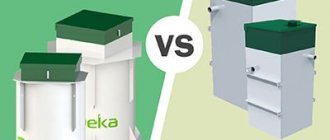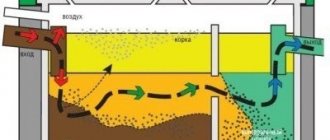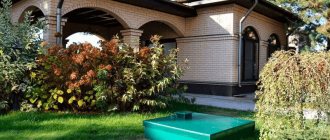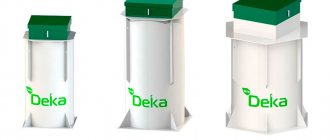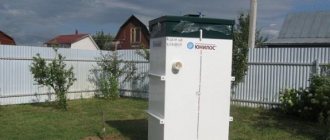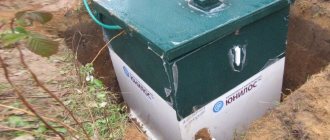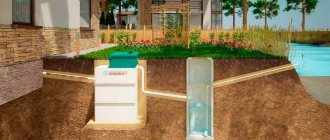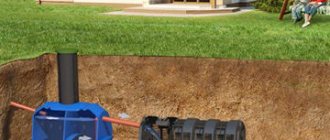Septic tanks “Biodeka” and “Topas” are produced by domestic companies and have been on the market for many years, during which they have proven their reliability and efficiency in operation. The indicators of Topas and Biodeka are approximately at the same level; both systems work well in difficult climatic conditions, can be used in winter and are suitable for installation even in wetlands. Which septic tank to choose, Topas or Biodeka for organizing an effective system for processing household wastewater in a country house? Both stations cope well with their tasks and purify waste to the level of process water. To determine which modification is best suited for specific tasks, it is necessary to conduct a detailed comparison of Biodeck and Topas septic tanks.
Which is better - BioDeca or Topas? Both systems are good in certain conditions. Each has its own advantages and disadvantages, which we will discuss further.
Case Features
Biodeck or Topas - comparison of septic tanks by type of construction and body materials. The tanks of both stations are made of high-quality materials that are resistant to corrosion and can withstand significant temperature changes in the range from -40°C to +40°C. The body of the Biodeck is made in a cylindrical shape and is equipped with additional stiffening ribs; the wall thickness is 10 mm. The Topas design is represented by a parallelepiped with reinforced double-type stiffening ribs, due to which the wall thickness is significantly greater than that of its competitor and is 15 mm. What is the difference between the Biodek sewer system and Topas? Both septic tanks can be installed in wetlands, without the risk of floating or deformation of the body during operation. According to the internal structure of the system, they differ in the shape of the secondary settling tank: Biodeck is a trapezoid, Topas is a truncated pyramid.
Comparison of types of sewer system
Unlike the sewer system of an apartment building, where waste goes far beyond the boundaries of the area, plumbing waste from a private house is collected on the site. Several types of local sewage systems are used to drain wastewater.
Which autonomous sewage system to choose:
- Cesspool. The simplest and cheapest way to collect wastewater.
- Cumulative plastic septic tank with several chambers for receiving and processing wastewater. The main disadvantage is the need for frequent pumping with a sewer truck. Poorly made tanks can cause depressurization, as a result of which wastewater can go into the ground.
- Septic tanks with soil post-treatment, which consist of settling tanks, filters and drains. The wastewater undergoes double purification, after which the resulting liquid goes into the ground through a layer of crushed stone.
- The installation of deep biological treatment involves the installation of 3-4 chambers through which wastewater passes. At the last stage, you can obtain 98-100% purified water, which can be used for watering the garden.
You should not buy sewer systems that are too cheap.
Each of the local sewer systems has its own pros and cons, which should be taken into account when choosing a treatment plant for a private home.
For long-term living in a house, it is better to install a deep cleaning station, which is the least demanding and most environmentally friendly.
The remaining types are suitable for installation on sites of country houses or estates for summer living.
Performance
Manufacturers of both models present a wide range of different modifications that are designed to perform various tasks: servicing private houses with a small number of people living, ensuring efficient wastewater treatment at commercial facilities and industries where up to 150 people work simultaneously. Biodeck is better than its competitor, surpassing it in the range of models for small country houses. The smallest station weighs 100 kg and is capable of producing 600 l/day. Topas's youngest model weighs twice as much, and its productivity is only slightly superior to its competitor and is 800 l/day.
Tips for choosing
The lack of central sewerage in private houses forces owners to install an autonomous waste drain. An autonomous waste treatment system allows wastewater to be purified by 98% or more due to the presence of aerobic bacteria.
When choosing a sewer system, you should take into account the financial capabilities and needs of the residents of the house
The process of equipping the system can be carried out at the construction stage of a country house, but sometimes it is allowed to install it in a ready-made house.
The home owner must decide on the type of treatment system based on the budget.
What to pay attention to:
- The number of people permanently living in the house affects the frequency of using the toilet and shower, and, accordingly, the volume of the tank or cesspool for wastewater;
- The performance of the treatment system is indicated in the documents for autonomous sewerage equipment;
- Depth of passage of sewer pipes;
- Material for the manufacture of autonomous sewage systems (concrete, plastic, metal). The design features of the system and its service life depend on the selected material;
- Terrain features - slope or elevation of the site;
- Soil characteristics affect the complexity of installing a sewerage system;
- The presence of groundwater nearby or the presence of reservoirs not far from the drainage pit;
- The ability to provide an autonomous sewage system with a constant power supply if it is equipped with pumps or special cleaning filters.
The size of the plot is also important to consider when installing an autonomous sewer system, since it is very important to choose the right location for the installation of a septic tank or cesspool. The waste pit must be located at a certain distance from the residential building so that unpleasant odors do not overshadow the lives of the residents of the house.
Characteristics and installation features
The operational life of both stations, subject to the requirements for regular maintenance, is 50 years. The differences lie in the operating principle; Biodeka uses a single-phase cleaning mode, which significantly increases the service life of the electrics. Topas operates in two phases, which consumes the resource of electrical equipment faster, but the quality of cleaning increases. The ability to install in any type of soil is an undoubted advantage of the presented models. The only difference during installation is the body material of the Topas septic tank. It has thicker walls, which increases the overall weight and requires more people to install. Otherwise, the installation technology is no different.
Septic tanks
The basis of liquid waste is ordinary water, and the task of an autonomous sewage system is to ensure its purification to a safe level. Then there will be no need to collect and store large amounts of wastewater. This problem is solved with the help of septic tanks, which separate mechanical, biological and chemical contaminants from water.
The separation of water from solid insoluble impurities occurs by flowing wastewater from one container to another. In this case, the water is not completely purified and requires additional purification, which is carried out using various filtration systems. Let's take a closer look at the design and operation of septic tanks with various filtration systems. This will allow you to select the most suitable device for specific conditions, taking into account all factors.
Septic tank with filtration well
Installation of a septic tank with a filtration well. Treatment facilities of this type can be built independently from available materials, or you can purchase ready-made, technically equipped devices for these purposes.
A septic tank with a filtration well consists of the following elements:
Inside the container there are compartments through which the wastewater is cleaned of solid impurities. The filtration well is installed so that its lower edge is above the groundwater level. A two-layer cushion is poured at the bottom, consisting of coarse-grained river or quarry sand, on top of which crushed stone of medium and fine fractions is poured.
One of the options for implementing such waste disposal is a system of overflow wells. Treatment facilities of this type can be built from brick or concrete rings without the involvement of specialists. This circumstance significantly reduces the costs of their creation and operation.
The principle of operation of a septic tank with a filtration well. Wastewater flows through a pipeline into a sump with a sealed bottom, solid particles settle to the bottom, and insoluble fats float to the surface. In some cases, there may be several such settling tanks through which wastewater flows sequentially.
Partially clarified water flows through a connecting manifold embedded into the wall of the container at a height of 2/3 from the base into a filter well. At the bottom of this structure there is a cushion of sand and crushed stone, through which moisture seeps. To reduce odors from the sump, it is recommended to periodically use additives containing cultures of anaerobic bacteria. Microorganisms effectively decompose biological waste into relatively safe components.
Gradually, the pillow becomes silted and the crushed stone and sand need to be replaced with clean ones, after which the well will be able to fulfill its task again. In this case, the process of siltation of the well slows down significantly; liquid waste must be pumped out no more than once every six months. The operating time of the structure until the bottom of the well is completely silted largely depends on the composition of the soil.
Sandy and sandy loam soils absorb water well and, therefore, have a greater resource, while clay and loams practically do not absorb liquid, and wells quickly become clogged. The gravel-sand cushion in the filtration well is replaced approximately once every five to six years.
+ Advantages of septic tanks with a filtration well
- The main advantage of a septic tank with a well is its simplicity of design.
- Significant periods of time between regular maintenance operations.
- Complete system energy independence.
— Disadvantages of septic tanks with a filtration well
- It is not possible to place at high groundwater levels.
- Not suitable for clay soils.
- The level of wastewater treatment is not high.
- It is necessary to regularly clean the septic tank from sludge, but not as often as from cesspools.
- After 5-6 years you will have to change the gravel-sand cushion in the well; the operation is very dirty and labor-intensive.
In what case can it be used? The performance of such systems strongly depends on the composition of the soil and the groundwater level. Such treatment plants are used in houses designed for year-round residence of a family of three to four people. The system is unable to cope with a burst discharge, which can lead to its overflow and liquid waste leaking onto the ground. The uninterrupted operation of such a system is guaranteed if it is used on sandy and sandy loam soils, as well as chernozem and loam with a predominance of sand, with low groundwater levels.
Septic tank with filtration field
Construction of a septic tank with a filtration field. Tightening environmental standards leads to the need to improve autonomous treatment facilities. A multi-stage septic tank with a filtration field is a complex system and includes the following components:
1. Sump. 2. Distribution well. 3. Underground filtration fields. They consist of perforated pipelines and gravel-sand cushions located in the ground, which act as filters. The thickness of the filter element is 1 meter or more.
The operating principle of a septic tank with a filtration field. Wastewater from the internal sewerage enters a settling tank consisting of two or three chambers. In the first compartment, the waste settles, and insoluble contaminants gradually settle and float to the surface. The clarified water is poured into the next chambers, where it undergoes subsequent stages of purification. Next, the water from the sump flows into the distribution well. From the well, water enters the pipes of the filtration field and, seeping through holes in the pipes, is almost completely absorbed in the fields.
Some systems are equipped with another well, which is installed behind the filtration field, as well as a drainage system. Water enters this well from the drainage system, which is then pumped out into the drainage channel using a pump.
To accommodate such structures, significant areas of over 30 square meters are required. meters. The productivity of underground filtration fields largely depends on the composition of the soil: the best option is sand, the worst is clay. Purified water enters the aquifer or is collected in drainage ditches or wells. The service life of fields before silting is approximately 10 years, after which the sand and gravel bed must be replaced.
+ Advantages of a septic tank with a filtration field
- High performance.
- Does not require maintenance for a long period.
— Disadvantages of a septic tank with a filtration field
- Large areas are required to install a filtration field.
- The level of water purification from contaminants in such systems is not high enough for its use even for irrigation or household needs.
- High cost of construction.
- After about 10 years, the filtration system will become silted and will need to be reconstructed, which is an expensive and labor-intensive process.
In what case can it be used? The use of septic tanks with filtration fields is only possible on large plots of land. The high performance of such structures allows them to be used in houses with a large number of residents.
On the sites under which the filtration fields are located, it is possible to lay out flower beds and lawns; planting of cultivated plants, trees and shrubs is prohibited. The accumulation of harmful substances in the fruits of cultivated plants can lead to an outbreak of gastrointestinal diseases.
Septic tank with infiltrator
The infiltrator is a replacement for drainage pipes, and its main advantage is a much smaller area compared to the filtration field. The infiltrator is a long plastic tank that resembles a trough. Only it is installed bottom to top and has an inlet and outlet. An infiltrator with a volume of 400 liters is capable of replacing about 35 meters of filtration field pipes.
Construction of a septic tank with an infiltrator. According to the design, septic tanks with an infiltrator are of two types: with an intermediate well located between the septic tank and the infiltrator and without it.
A septic tank with an infiltrator consists of the following components:
1. Septic tank; 2. Pipe; 3. Cushion made of crushed stone; 4. Infiltrator; 5. Ventilation.
A septic tank with an infiltrator and an intermediate well consists of the same elements, but additional devices are added here, which you can see in the infographic below.
Infiltrator in section.
Infiltrator installation process.
The principle of operation of a septic tank with an infiltrator. First, let's look at the operating principle of an infiltrator without a well. Sewage flows into a septic tank where, passing through several chambers, it undergoes a certain cleaning. Then, by gravity through the pipeline, they enter the infiltrator tank and are absorbed into the crushed stone.
The operating principle of an infiltrator with an intermediate well. The wastewater passes through the septic tank and enters an intermediate well, where a drainage pump with a float is located, which rolls the water into the infiltrator. The wastewater is then absorbed into a bed of crushed stone. This system is used to prevent wastewater from flowing back into the septic tank. The system is intended for use in areas with high groundwater levels and poorly absorbed soils.
+ Advantages of a septic tank with an infiltrator
- Doesn't take up a large area.
- Easy installation.
- An infiltrator with an intermediate well and pump can be installed in areas with high groundwater levels.
- Copes with volley discharge of wastewater.
- Rare system maintenance.
— Disadvantages of a septic tank with an infiltrator
- Over time, the infiltrator will have to be cleaned and the crushed stone cushion replaced, but this will not happen soon.
- A septic tank with an infiltrator and an intermediate well with a pump is energy-dependent.
- The level of water purification is not high enough.
- The area above the infiltrator can only be used for lawn.
In what case should you use a septic tank with an infiltrator? It is advisable to place this system on well-absorbent soils, such as sand, black soil, loam with small inclusions of clay and low groundwater levels. Structures of this type are capable of absorbing a large amount of wastewater, including flood discharges, when a large amount of water enters the septic tank at once. Can be used in houses with a large number of residents.
In what case is it necessary to use a septic tank with an infiltrator and an intermediate well? It is advisable to use a system with an intermediate well and pump in areas with high groundwater levels. The use of an intermediate well with a pump and a check valve prevents wastewater from flowing back into the septic tank, if the wastewater entering the infiltrator is absorbed very slowly.
Lugs
Special elements that allow you to securely secure the station in the pit and prevent the danger of floating during operation. At Topas stations, the role of lugs is played by rigging strips, and at Biodek, a square-shaped sheet is welded to the bottom of the cylindrical body, the protruding corners are lugs. When backfilling, the main load falls on the protruding corners of the lugs; this design has proven its effectiveness over the years of use.
Electrics
Automation elements for Topas septic tanks are more expensive compared to Biodeka stations. In the first option, both compressors and a float-type sensor are responsible for the speed of movement of wastewater through the septic tank and cleaning. These elements may fail. A different approach is used in the production of Biodeca stations. Efficient performance and the required compressor pressure are achieved due to the adjusted diameters of the main mechanisms and several cleaning compartments.
The best manufacturers of autonomous sewers for private homes - which company to choose
You can do a tremendous amount of work - perform all the calculations, select a site for planting equipment, find out the groundwater level and geological section.
Then buy a septic tank, dig a pit, install equipment, connect pipelines, perform waterproofing and insulation, and backfill the soil.
After some time, it may turn out that the plastic has cracked, sewage has “dirtied” the entire garden plot, and it is simply impossible to breathe at home.
That is why, in order not to miss the choice, it is better to buy, albeit a little more expensive, a high-quality autonomous sewer system that will not upset you over time.
These are the systems produced by the following companies:
- "Eco-Grant" (Topas, Topol).
- "Unilos" (Astra).
- "Chistok" (Chistok).
Continuing the topic raised, in this article we present the best models of autonomous sewers, among which we recommend making your specific choice.
Recommendations: 11 Best Drain Cleaners
12 best pumping stations
12 Best Reverse Osmosis Systems
Film degasser
The presence of automation operating in two-phase mode in Topas models allows the use of a film degasser during the second stage of wastewater treatment. Thanks to its work, fatty deposits are removed and redirected to the aeration tank, where under the influence of aeration the film is finally destroyed. This increases the cross-sectional area of the airlift and reduces the likelihood of blockages, which makes the topas better. In Biodec models, the degasser is located in the secondary settling tank, where it performs its functions in one cleaning phase.
